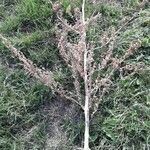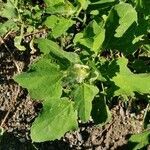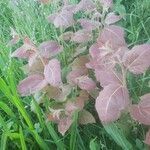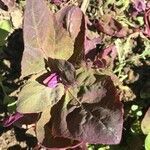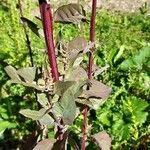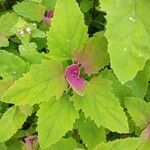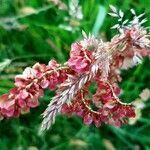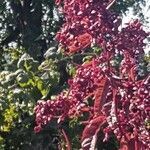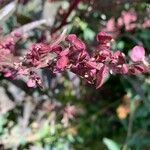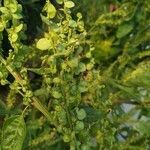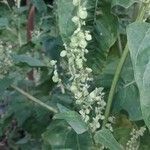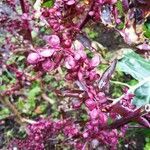Herbs annual, to 2 m tall, slightly furfuraceous. Stem erect, stout; branches oblique or spreading, obtusely 4-angled, green striate. Petiole 1-3 mm; leaf blade green on both surfaces, ovate-oblong to ovate-triangular, 5-25 × 3-18 cm, adaxially slightly furfuraceous, base hastate to broadly truncate, margin entire or irregularly serrate, apex subobtuse. Inflorescences axillary and terminal panicles with bisexual and female flowers mixed in glomerules. Bisexual flowers ebracteate; perianth 5-parted; segments oblong; stamens 5, sometimes undeveloped and flowers appearing female; seed horizontal, lenticular, 1.5-2 mm in diam.; testa black, sublustrous, thinly leathery. Female flowers bracteate; perianth absent; fruiting bracts very shortly petiolate, connate only at base, suborbicular, 1-1.5 cm in diam., both surfaces reticulate veined and glabrous, base truncate or slightly emarginate, margins entire, apex acute; seed vertical, compressed globose, 3-4 mm in diam.; testa yellow-brown, not lustrous, usually membranous. Fl. and fr. Aug-Sep.
Herbs, green to yellowish or reddish, 5-15(-25) dm, glabrous. Stems erect, mostly branched. Leaves mostly opposite or mostly alternate; petiole 0.3-4+ cm; blade green on both sides, ovate or ovate-lanceolate to cordate-hastate at base, 15-180 × 8-135 mm, margin entire or more rarely irregularly toothed or lobed, apex attenuate to acuminate or rounded. Inflorescences of spikes disposed in leafless panicles. Staminate flowers 5-merous. Pistillate flowers dimorphic, some ebracteolate and with 5-parted perianth, others without perianth enclosed by a pair of sessile or very shortly stipitate bracteoles. Fruiting bracteoles samaralike, orbicular to oval or ovate, compressed, 5-18 mm, united only at base, entire, faces smooth. Seeds of ebracteate flowers black, horizontal, convex, 1-2 mm wide, lustrous; those of bracteolate flowers olivaceous brown, vertical, flat, 3-4.5 mm wide, dull. 2n = 18.
Erect or decumbent, to 2 m; lvs becoming green, ovate to broadly deltoid, to 15 cm; staminate and pistillate fls in separate spikes or mingled, forming a large, paniculate infl; some pistillate fls with a horizontal seed, 4–5-lobed persistent cal, and no bracteoles, but most with vertical seed, no perianth, and 2 persistent bracteoles (as in other spp. of Atriplex); fruiting bracteoles thin, separate, to 15 mm, rotund-ovate or suborbicular, broadly obtuse, entire or denticulate, conspicuously reticulate; seed apparently central, its radicle inferior; 2n=18. Native of Asia, cult. as a pot herb, and rare as a waif in our range. (A. nitens)
Erect annual herb to 2.5 m high, monoecious. Branches angular. Leaves petiolate; lamina 5–10 cm long, thin, almost glabrous, the lower ones triangular, cordate or hastate at base, entire to dentate. Flowers mixed in a terminal spike or panicle. Female flowers dimorphic, some lacking bracteoles but with 5-lobed perianth and horizontal or vertical seeds, others with bracteoles and no perianth and with vertical seeds; bracteoles orbicular to very broadly ovate, flattened, free except at base, entire, papery, reticulate-veined, c. 10 mm long. Seed circular; radicle horizontal, basal.
An annual herb. It grows up to 2 m tall and spreads 40-50 cm wide. The leaves are triangular. They are greyish green. They can be red or yellow. They are 10-15 cm long and have small teeth along the edge. The flowers are in clusters at the ends of the plant. These can be 20 cm long. They are green or red but insignificant. The fruit are very small brown plate like seeds. There are several named cultivated varieties.
